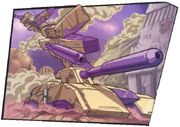All right. So you have a character now! Congratulations! Now, before you go IC and start enjoying the continuing adventure of the Transformers Universe, there are a few things you need to do, to set your character up to be ready for what's ahead.
BASIC COMMANDS[]
The following commands will help get you started on the MUX.
- +bbnext - Start reading posts on our internal billboard system
- +who - to see who is on
- +where - where people are
- look <whomever> - look at someone
- +ic / +ooc - hop In Character or Out Of Character
- g <whatever> - talk on the guest channel
- "<whatever>- say something in the room
- :<whatever> - make a pose starting with your name
- @emit <whatever> - Emit a pose without your character's name prepended
- +finger <name> - the In Character information on a character
- +personal <name> - Personal, OOC information on the character and player
page <name>=<Message>- Talk to people anywhere on the MUX.
Transform Coding[]

TURANSFOAAAAAAM!
The first, for Transformers, and for civilian 'mode' for GI Joe characters, is the transform coding. The transform code goes as follows:
+transform #
So, +transform 2 to go into altmode, and then +transform 1 to return to root mode.
Mode descs: Mode descs define the description you have when you transform to a mode. Setting these up is a fairly painless affair. To do it, use this:
&desc_1 me=<mode 1 description> (IE: &desc_1 me=A robot.) &desc_2 me=<mode 2 description> (IE: &desc_2 me=A car.)
These are just general examples, for simplicity, if you check +Stats, your mode names will be listed, to give you an idea of what kind of description you should have for a particular mode. Descriptions should be, well, a lot longer than the examples given, but less than a screen length, if possible. (Not every one has scroll back and twenty minutes to read your novel-length desc while people wait to RP. ^_^)
Once you've set the desc, transform from one mode and back to set the new desc as your current desc, or @desc me=Whatever to just set the current desc directly (although @desc will be wiped out by &desc_# when you transform).
Set Names[]
After you set your descs, you can also set names for your alternate modes. This would be a vehicle name usually for a transformer; for a human, this might be the civilian name of the character. To set your alt-name, use this:
&name_2 me=<name> (IE: &name_2 me=Blue Corvette)
That's easy enough, yes? Once you have your name_2 (and name_3 for Triple Changers) set, you're ready to move on.
Transform Message[]
The next fun thing you need to set up on your character is the transform message. Remember how the Transformers unfolded and transformed? Well, now's your chance to describe in your own words what happens. To set this message up, use this:
&transform_msg_1 me=<message to emit when you transform to mode 1>
(IE: &transform_msg_1 me=The semi launches in the air from the
front, the arms unfolding from the sides, legs folding downward
from the back.)
Repeat the same procedure for the message when you transform into mode 2, using a 2 instead of the one.
Try to keep these down to one or two lines, as they emit to everyone in the room and tend to get spammy.
Comm System[]
To use the comm system, see 'help addcom'. In brief, to add a channel, use
addcom <alias>=<channel>
Example: addcom +a=Autobot
Then, to use the channel, just type
<alias> <text/pose>, i.e.: +a Hello!
<Autobot> Typhoon says, "Hello!"
addcom is case sensitive, so, addcom +a=autobot won't work. Use @clist to get a list of available channels, and comlist for a list of channel to which you already belong.
+personal[]
Now, on to the +personal information! The ooc information command on TFU is coded as both +oocfinger and +personal -- both reveal the same information.
The fields of +personal match the attributes that need to be set for filling it in. So, for Alias, use @alias me=<whatever>. For the rest, the attrs correspond to the fields they go in. So, &<field> me=<value>. That's it!
